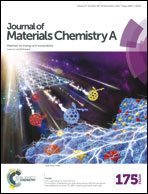Insights into the working mechanism of cathode interlayers in polymer solar cells via [(C8H17)4N]4[SiW12O40]†
Abstract
A low-cost (<$1 per g), high-yield (>90%), alcohol soluble surfactant-encapsulated polyoxometalate complex [(C8H17)4N]4[SiW12O40] has been synthesized and utilized as a cathode interlayer (CIL) in polymer solar cells (PSCs). A power conversion efficiency of 10.1% can be obtained for PSCs based on PTB7-Th (poly[[2,6′-4,8-di(5-ethylhexylthienyl)benzo[1,2-b;3,3-b]-dithiophene][3-fluoro-2[(2-ethylhexyl) carbonyl] thieno [3,4-b]-thiophenediyl]]):PC71BM ([6,6]-phenyl C71-butyric acidmethyl ester) due to the incorporation of [(C8H17)4N]4[SiW12O40]. Combined measurements of current density–voltage characteristics, transient photocurrent, charge carrier mobility and capacitance–voltage characteristics demonstrate that [(C8H17)4N]4[SiW12O40] can effectively increase the built-in potential, charge carrier density and mobility and accelerate the charge carrier extraction in PSCs. Most importantly, the mechanism of using [(C8H17)4N]4[SiW12O40] as the CIL is further brought to light by X-ray photoemission spectroscopy (XPS) and ultraviolet photoemission spectroscopy (UPS) of the metal/[(C8H17)4N]4[SiW12O40] interface. The findings suggest that [(C8H17)4N]4[SiW12O40] not only decreased the work function of the metal cathodes but also was n-doped upon contact with the metals, which provide insights into the working mechanism of the CILs simultaneously improving the open circuit voltage, short circuit current and fill factor in the PSCs.
![Graphical abstract: Insights into the working mechanism of cathode interlayers in polymer solar cells via [(C8H17)4N]4[SiW12O40]](/en/Image/Get?imageInfo.ImageType=GA&imageInfo.ImageIdentifier.ManuscriptID=C6TA08268H&imageInfo.ImageIdentifier.Year=2016)

 Please wait while we load your content...
Please wait while we load your content...